What is Mang Lang Church like?
Mang Lang Church sits in the countryside of Tuy An District, about 35 kilometers north of Tuy Hoa, surrounded by rice fields and village roads that feel far removed from the city. The setting is calm and rural, and when you arrive the atmosphere is more about quiet reflection than sightseeing crowds. The church itself dates back to the late 19th century and is tied to two important figures in Vietnamese Catholic history: Alexandre de Rhodes, who compiled the first book in Romanized Vietnamese, and Saint Andrew of Phu Yen, considered the first Catholic martyr of the country.

Today the church is still in use, with local parishioners gathering for mass, while visitors come to see its faded Gothic façade and learn about its cultural significance. It’s not a grand cathedral like those you might see in Hanoi or Saigon, but rather a modest and layered site where history, religion, and local life come together in a simple yet meaningful way.
History of Mang Lang Church
Mang Lang Church was built between 1892 and 1907 by the French missionary Father Joseph Lacassagne. Designed in a Neo-Gothic style with tall arches and twin towers, it remains one of the oldest Catholic churches in Vietnam. Its name comes from the mang lang tree, once common in the area with its wide canopy and purple blossoms — a piece of natural history that still lingers in local memory.
The church’s roots stretch further back than its construction. In the early 1600s, Princess Ngoc Lien, daughter of Lord Nguyen Phuc Nguyen, was baptized here and helped establish one of the first Christian communities in the region. It later became connected to Saint Andrew of Phu Yen, executed at only 19 years old for his faith in 1644 and now remembered as the patron saint of Vietnamese youth. These stories make the site deeply symbolic for Vietnamese Catholics, far beyond its modest size.
Another lasting legacy is the link to Alexandre de Rhodes, the missionary credited with compiling the Phép Giảng Tám Ngày (The Eight-Day Sermon), printed in Rome in 1651. This was the first book in Romanized Vietnamese, laying the foundation for the Quốc Ngữ writing system that is used today. Combined with its position near former regional centers such as Tien Chau Port and An Tho Citadel, Mang Lang Church represents a meeting point of religion, culture, and history in central Vietnam.
Highlights of visiting Mang Lang Church
Mang Lang Church is not a large complex, but there are several layers to explore if you take the time. Most people spend around half an hour to an hour here, often as part of a day trip that includes Da Dia Reef, O Loan Lagoon, or other nearby sights. What makes it interesting is the mix of architecture, history, and quiet devotional corners that give you a glimpse into both local life and Vietnam’s early Catholic story.
1. Gothic façade & architecture

The church’s faded blue-grey exterior is its most photographed feature. Two tall bell towers flank a central cross, with pointed arches and decorative stonework giving it a classic Gothic look. Some details, like the narrow windows shaped like bamboo shoots, add a distinct local touch. Its weathered state adds to the charm, and the façade catches the light beautifully in the early morning or late afternoon.
2. Church interior
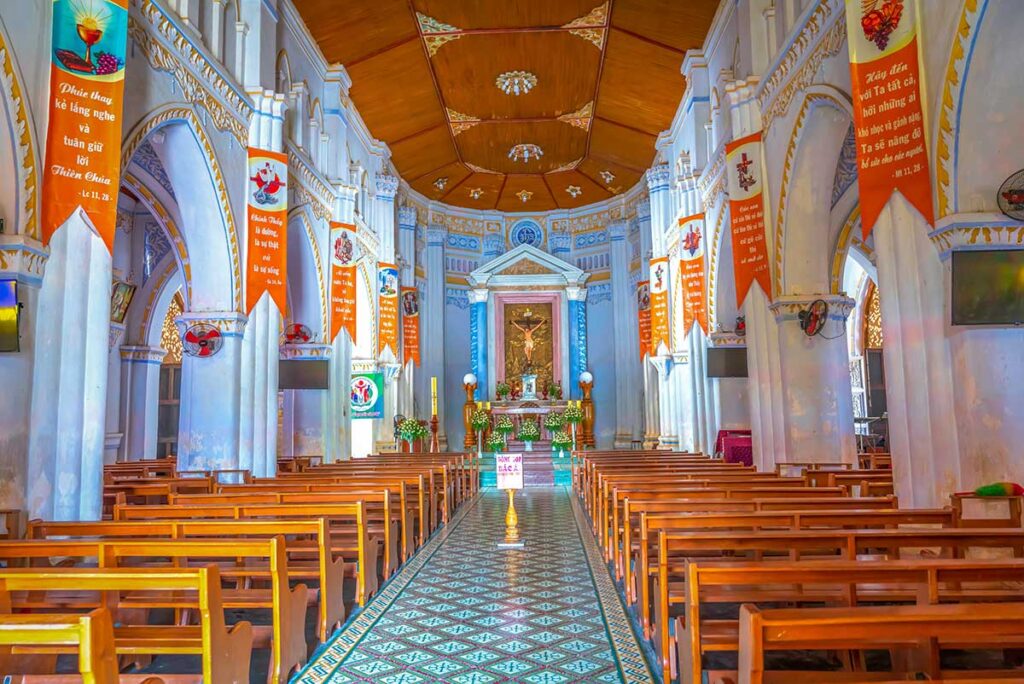
Inside, the church is modest but atmospheric. You’ll find wooden ceiling panels, a tiled floor, and stained-glass windows that let in filtered light. It lacks the grandeur of larger cathedrals such as Notre Dame in Saigon, but that simplicity is part of the appeal. The nave and altar are still used for regular services, so it’s a place where you can quietly sit and experience a working parish church.
3. Underground grotto chapel
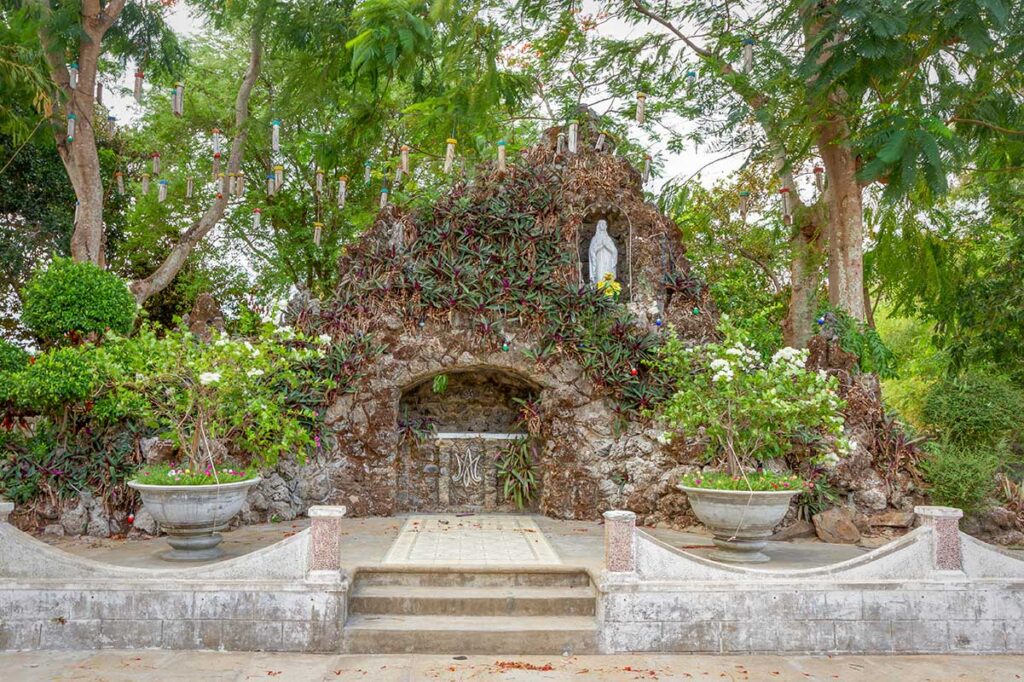
A man-made cave beside the church leads into a dim, chapel-like space with faux-stalactite walls, chandeliers, wooden benches, and a small altar softly lit in blue.
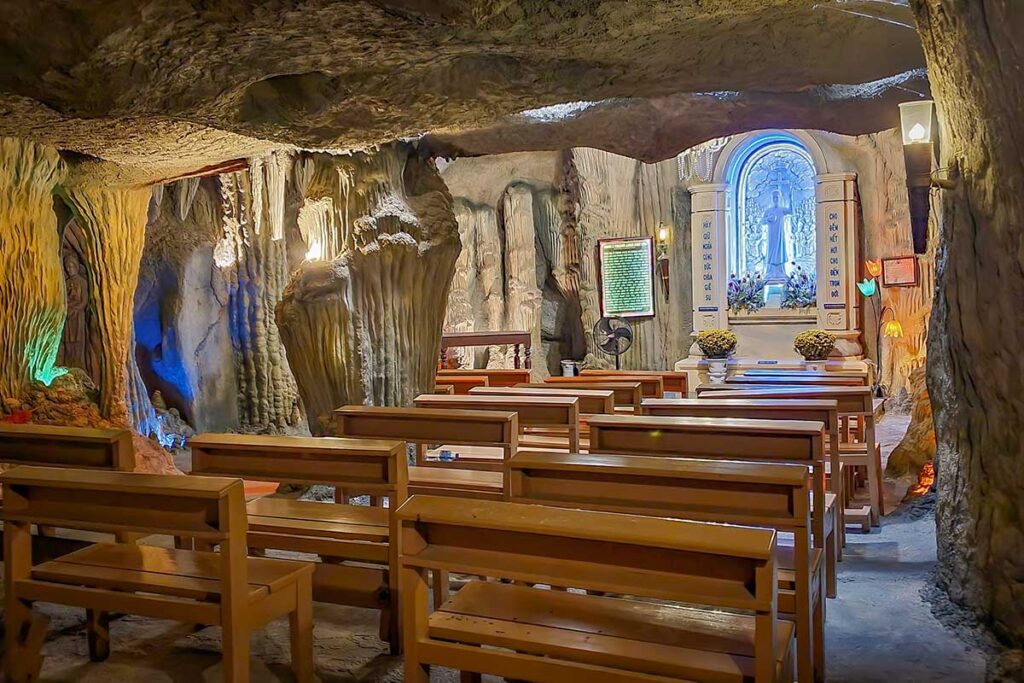
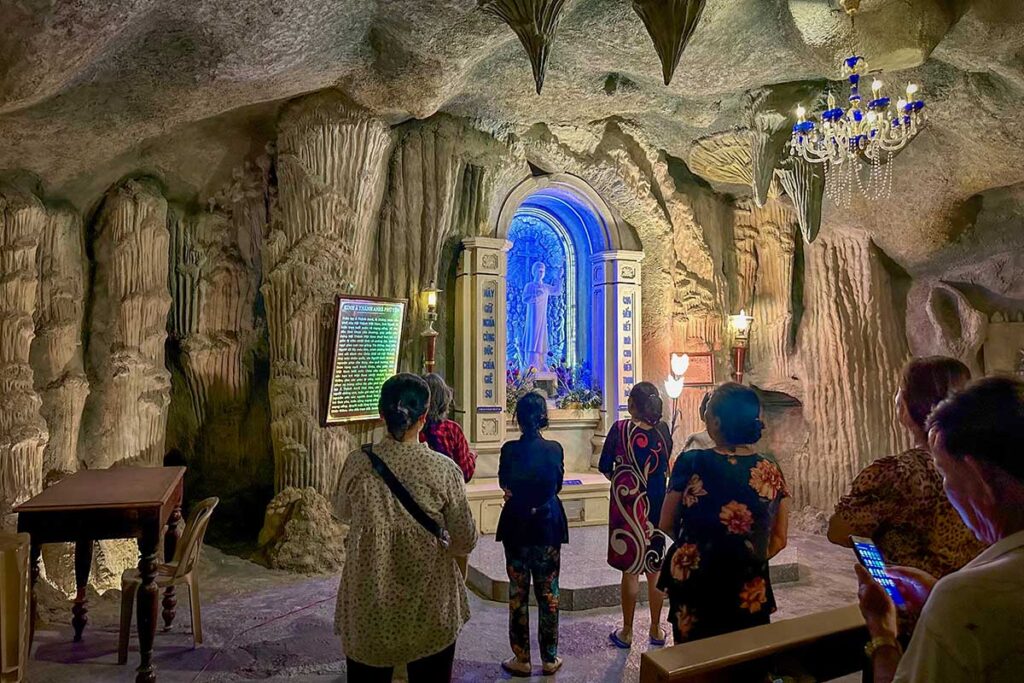
Along the passageways, you’ll see displays about Saint Andrew of Phu Yen and early missionary history, giving the grotto both a devotional and museum-like feel. It’s modest but atmospheric, and often surprises visitors who expect only the Gothic church above.
4. The Eight-Day Sermon (Phép Giảng Tám Ngày)

One of the most important treasures connected to Mang Lang Church is a preserved copy of Alexandre de Rhodes’ Phép Giảng Tám Ngày, first printed in Rome in 1651. This was the earliest book written in Romanized Vietnamese (Quoc Ngu) and laid the foundation for the writing system used across Vietnam today. Seeing the book, displayed in a protective glass case, connects the visit not just to local religious history but to a turning point in the country’s cultural development.
4. Statues & memorials in the garden

Scattered around the grounds are statues of saints and a memorial to Saint Andrew of Phu Yen, the young Catholic martyr associated with this region. The garden is small but peaceful, with shaded spots where you can pause for a few minutes before continuing your trip.
5. Old house with memorabilia
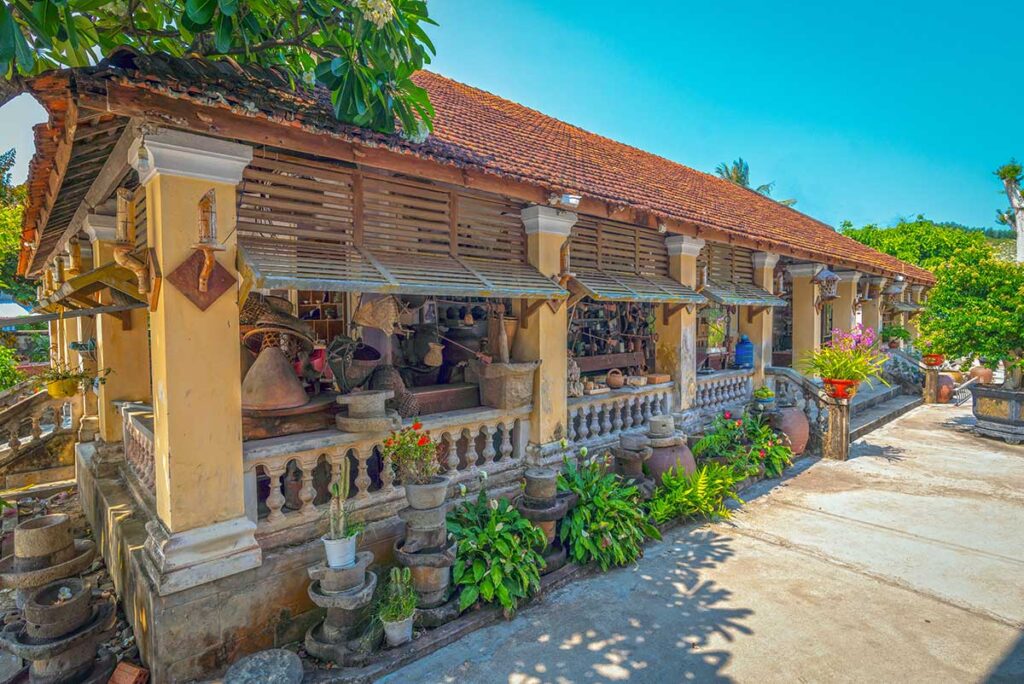
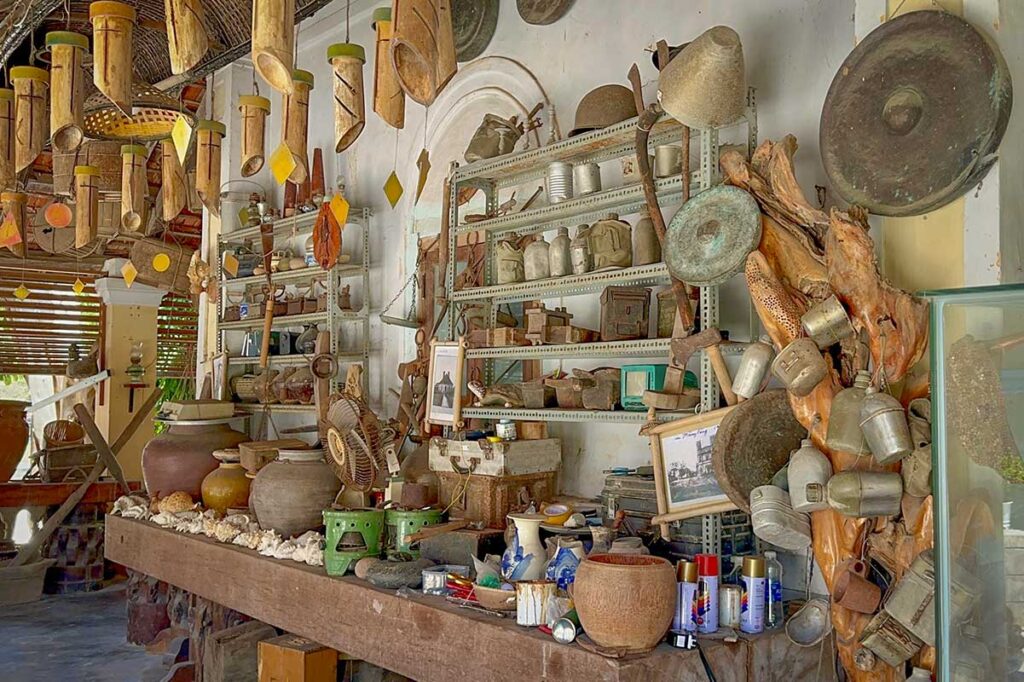
Next to the church is an old house that feels part museum, part souvenir shop. Inside you’ll find a curious mix of 19th–20th century household tools, pottery, musical instruments, and even pieces of coral. It’s not curated in a polished way, but if you enjoy quirky local displays, it adds another layer of interest to the visit.
Location & Getting there
Where is Mang Lang Church?
Mang Lang Church sits in An Thach Commune, Tuy An District, around 35 km north of Tuy Hoa, the provincial capital of Phu Yen. Tuy Hoa itself is easy to reach by train along the North–South railway, by long-distance bus, or via Dong Tac Airport, which has daily domestic flights. From Tuy Hoa, most people visit the church as part of a half-day or full-day outing that also takes in other Tuy An landmarks such as Da Dia Reef or O Loan Lagoon.
Car with driver
For most international travelers, hiring a private car with driver is the most practical option. It makes the journey straightforward and allows you to combine several stops in one trip, without worrying about navigation or parking. Drivers usually wait while you explore, and prices are agreed in advance, making it a stress-free way to link the church with highlights like Ong Cop Bridge, Da Dia Reef, or Yen Island.
Renting a motorbike
If you prefer more independence, renting a motorbike in Tuy Hoa is easy and affordable. The ride to Tuy An takes about 45–60 minutes, with mostly light traffic and a few winding stretches near the coast. It’s a scenic and enjoyable way to explore if you’re confident on two wheels. Officially, you’ll need a valid motorbike license and an International Driving Permit for your insurance to be valid, although in practice rental shops rarely check.
Practical visiting information & Travel Tips
Entrance & costs
There’s no ticket fee to enter Mang Lang Church, though small donations are appreciated.
Opening hours
The church is generally open during daylight hours, but it often closes around lunchtime (12:00–14:00). Mornings or late afternoons are the most rewarding times to visit, both for the softer light on the façade and for the quiet atmosphere.
Facilities
Facilities are very basic. You may find a few small souvenir stalls and the old house with local displays, but don’t expect a polished visitor center. Toilets are available at nearby coffee shops.
Etiquette
As this is an active place of worship, dress modestly—covering shoulders and knees is recommended. Keep voices low, avoid crossing your legs while seated inside, and be discreet with photography. Outside photos are welcome, but ask before taking pictures during a service.
Time needed
Most visitors spend 30–60 minutes exploring the church, grotto, and garden. If you also stop by the old house or attend mass, you can easily extend your visit.
Sights nearby to combine with
Mang Lang Church is rarely a standalone destination. It fits easily into a wider Tuy An or coastal Phu Yen itinerary, with several highlights close by:
- Ganh Da Dia Reef (10 km) – A striking natural site of hexagonal basalt columns formed by ancient volcanic activity. Compact but unique, and one of the best-known landmarks of Phu Yen.
- O Loan Lagoon – A calm, scenic lagoon surrounded by seafood restaurants. Popular with locals for fresh shellfish and oysters.
- Ong Cop Bridge – A long wooden bridge crossing the river, photogenic and a reminder of rural life before modern highways.
- Yen Island – Offshore and reachable by boat, this small island features volcanic rock formations and good conditions for snorkeling.
- An Tho Citadel – The ruins of an old provincial citadel, once a local administrative center, add a historical stop to the circuit.
Taken together, these sights make Mang Lang Church part of a rewarding half- or full-day trip exploring Phu Yen’s coast.
Is Mang Lang Church worth visiting?
Yes — but with the right expectations. Mang Lang Church is best visited as part of a wider Tuy An or coastal Phu Yen itinerary rather than as a single-purpose trip from Tuy Hoa. On its own, the site is modest, but it rewards you with layers of history, cultural significance, and a tranquil countryside setting.
If you have an interest in architecture, Catholic history, or lesser-known landmarks that connect to Vietnam’s past, the church is a meaningful stop. Combined with nearby sights like Ganh Da Dia Reef, O Loan Lagoon, or Ong Cop Bridge, it becomes part of a varied and memorable day exploring Phu Yen.



